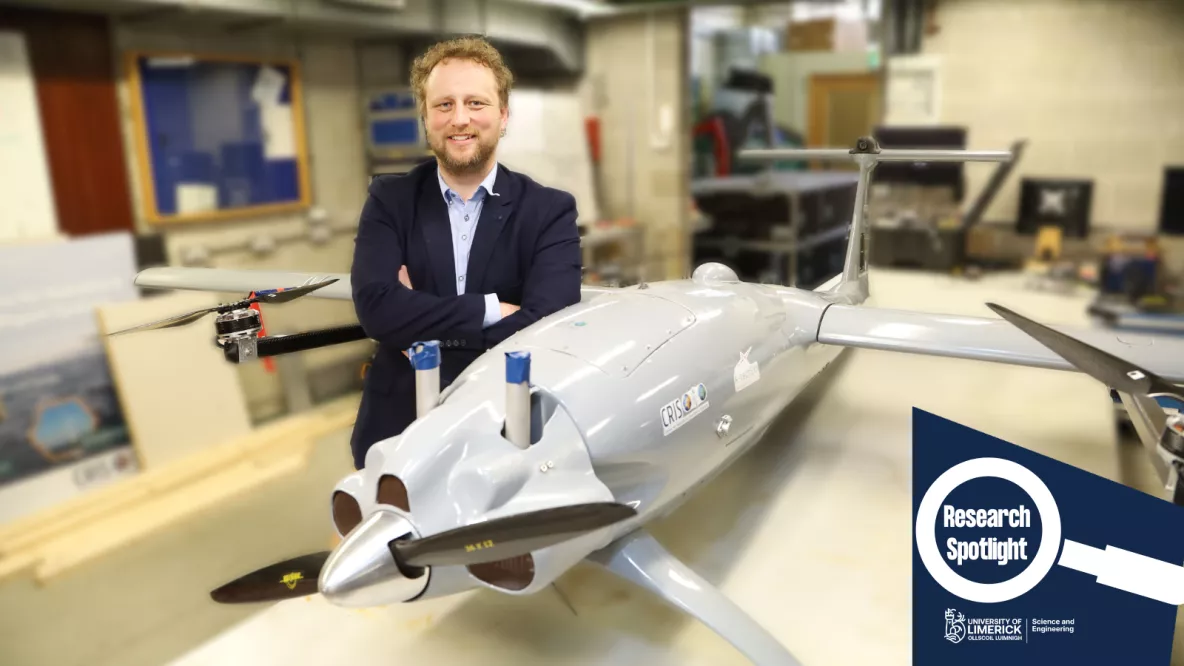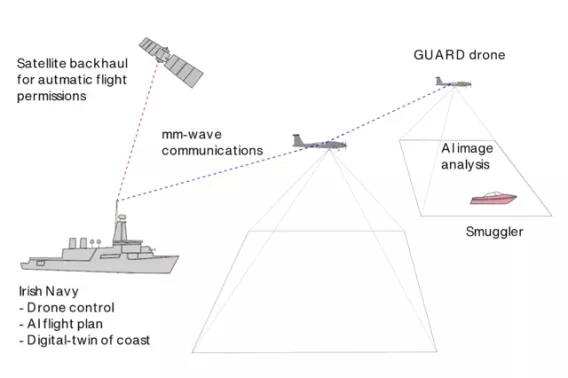

Gerard Dooly is an Associate Professor in the School of Engineering and is Co-Director of the Centre for Robotics and Intelligent Systems (CRIS) at University of Limerick.
A graduate of UL’s electronic engineering programme, Gerard’s interest in electronics started at a young age when he worked in an arcade business in Tramore.
“I got interested in electronics because as a school kid I used to work weekends and summers in an arcade fixing slot machines. I was constantly working with electronics, soldering different things and fixing machines.”
This interest led Gerard to study electronic engineering at UL and a research career focusing on sensors, underwater robotic engineering and advanced control and perception systems in remotely operated vehicles (ROV’s) and aerial drones. He is now leading UL’s research in the multiagency Drug Interdiction by Utilising Smart Drones Guard project.
The Guard project, funded through Enterprise Ireland’s Disruptive Technology Innovation Fund (DTIF), is a partnership between three Irish small and medium enterprises with expertise in drone technology, virtual reality, and additive manufacturing, three academic institutions, and the Irish Naval Service. The main goal of the project is to enable the Naval Service to survey large quantities of the Irish coastline using autonomous smart drones, Gerard explains:
“Ireland has quite a large rural coastline, so there's not many people looking out to sea which makes it easy to come into unpopulated areas of Cork, Kerry or even Donegal and illegally import drugs into this country. The Irish Navy has a limited number of ships at their disposal so it's hard to survey the coastline compared to other European jurisdictions that are more heavily populated, and don't have as vast a coastline right on the Atlantic.”
Along with the difficulties in surveying the Irish coast due to its size, there are also response times, weather conditions and the cost of manpower and CO2 to consider.
“Burning petrol or diesel to move patrol vessels and crew along the coastline to perform a survey, costs a lot in terms of manpower, CO2 and time. Those vessels move at maybe 12 knots or equivalent. The drones we are developing can fly in all types of weather up to a maximum speed of 100 kilometres an hour. So, for example, if I want to survey 200 or 300 kilometres to the north, I can launch my drone and be there within three hours and I can do that without burning CO2.”
The smart drones being developed as part of this project will be able to perform certain autonomous tasks using Artificial Intelligence (AI) systems that live ‘on the edge’ or within the body of the drone, and the development of these systems is UL’s main role in the project.
“We are developing AI and machine learning algorithms to identify vessels on the water at a distance. This will allow us to track or identify a vessel, its flag or name. These systems are known as perception systems and will allow the drone to interpret sensor data to understand its environment. If a vessel comes within range, it will detect it and do a course manoeuvre to get closer and get a better image.”
Other perception systems being developed at UL are detect and avoid systems using machine vision and smart sense technology, and Supervisory Control and Data Acquisition (SCADA) systems. These systems will allow the drone to detect and avoid objects, complete precision take-off and landing operations from a vessel at sea and identify if there is a problem using onboard sensors or the engine monitoring system. All of these developments are subject to small-scale testing before being implemented in full scale demonstrations.
“Developments in the Guard project are subject to small-scale testing, and we fly smaller drones nearly every week on campus. It's continuous development in terms of impact that gets rolled out through the product and collaboration with our partners. We test developments annually on the larger drones using an established flight area off the Wicklow coast.”
The Centre for Robotics and Intelligent Systems at UL were early adopters when it came to drone technology. Over the years, the centre has worked on many funded projects such as using drones and underwater vehicles for oil spill response. These projects have allowed Gerard to develop a team of experts in drone technology within the centre.
“Seven or eight years ago, there was hardly any drone research in the university and now we have 15 people working in this area and are recognised as one of the leaders in perception systems and drones within Europe.”
The potential uses of this technology are not lost on Gerard who is excited about its current and future application within engineering and sustainability.
“Drones have great potential for habitat monitoring and infrastructure monitoring. If you want to maintain infrastructure on a more prescribed basis you can do it cheaply and efficiently using a drone, this is particularly critical in the upcoming offshore wind sector. We are already seeing drones and autonomous systems working in many areas so it’s exciting to see their future application in industry from construction to energy production.”
More information about the DTIF Guard project can be found on their website: https://theguardproject.com/.
Postal Address: Science & Engineering Faculty Office, Lonsdale Building, 1st Floor, University of Limerick, Limerick, Ireland
Email: scieng@ul.ie
Phone: +353 (0)61 202109 or +353 (0)61 202642
